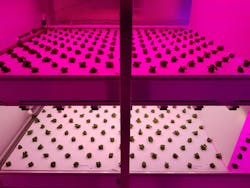Avoiding white light in the greenhouse can push down the energy bill
LED lighting might consume less energy compared to conventional sources, but it’s not “no energy.” That can be a deterrent for any user considering installing lights where there are none, especially with high electricity rates.
Nowhere is this truer than in horticultural greenhouse lighting, a sector where buying appears to have slowed as growers who not long ago might have spent on LEDs as supplemental photonic nourishment are instead continuing to rely purely on the sun.
But now Signify is putting out a message that the electricity bill does not have to be as high as feared. It notes that energy consumption will dip noticeably if the greenhouse operator minimizes white LED light, which the company points out is more energy intensive than the red and blue spectra.
As an extra incentive to switch off white, the Dutch company further points out that many crops grow better when not exposed to white.
White light, if used at all, should be limited to providing illumination if necessary to help workers see their way around the plants and the facilities, Signify notes.
Signify based its assertion first and foremost on a basil study it conducted not in a greenhouse, but at its Philips GrowWise Research Center in Eindhoven, at company headquarters. It cultivated the basil in three separate crops, each with the same 220 µmol/m2/s light level but with a different spectral mix of white, blue, and red.
The company noted that the highest yields came from a “deep red–blue” recipe, and that “fresh weight decreases as the proportion of white light increases.” According to the study, white light’s main impact was a negative one: It increased energy consumption.
While Signify studied basil in this instance, it pointed out that other studies — such as one by Holland’s Wageningen University & Research have shown the same general result with other crops and other light recipes.
“Signify’s research confirms previous experiences with other crops, which were also gained elsewhere,” the company said in a press release. “Research on young tomato plants at Wageningen University & Research (Dieleman et al., 2022) into the influence of green and white light yielded the same results. Research on lettuce and spinach, as well, has already shown that white light does not yield growth gains; rather, it only increases costs.”
Meanwhile, the horticultural lighting sector appears to still be experiencing a slowdown. Vendors including Signify, its Fluence division, and ams Osram have all alluded to a downturn over the last year.
Nevertheless, the sector continues to feature showcase agricultural and vertical farming installations and to attract investors as it puts forward the promise of global food security.
Signify is also encouraging growers to deploy internet-connected greenhouse lighting, noting that such IoT installations can gather data that, when analyzed, can help optimize lighting, climate control, and other factors on a crop-by-crop basis.
MARK HALPER is a contributing editor for LEDs Magazine, and an energy, technology, and business journalist ([email protected]).
For up-to-the-minute LED and SSL updates, follow us on Twitter. You’ll find curated content and commentary, as well as information on industry events, webcasts, and surveys on our LinkedIn page and our Facebook page.

Mark Halper | Contributing Editor, LEDs Magazine, and Business/Energy/Technology Journalist
Mark Halper is a freelance business, technology, and science journalist who covers everything from media moguls to subatomic particles. Halper has written from locations around the world for TIME Magazine, Fortune, Forbes, the New York Times, the Financial Times, the Guardian, CBS, Wired, and many others. A US citizen living in Britain, he cut his journalism teeth cutting and pasting copy for an English-language daily newspaper in Mexico City. Halper has a BA in history from Cornell University.





